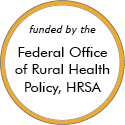Substance Use and Misuse in Rural Areas – Models and Innovations
These stories feature model programs and successful rural projects that can serve as a source of ideas and provide lessons others have learned. Some of the projects or programs may no longer be active. Read about the criteria and evidence-base for programs included.
Other Project Examples
Recovery Kentucky
Updated/reviewed April 2025
- Need: To provide housing and recovery services for rural Kentuckians dealing with substance use.
- Intervention: Recovery Kentucky has 8 rural locations and provides apartments within a congregate living environment and an opportunity to begin recovery from substance use disorder in a structured, peer-led 12-step environment.
- Results: The rural and urban centers serve up to 2,200 people annually. An independent university-led resident outcome evaluation showed significant improvements in clients' drug and alcohol use, housing and employment status, decrease in criminal justice improvement, and improved health and mental health.
Coast to Forest: Mental Health Promotion in Rural Oregon and Beyond
Updated/reviewed January 2025
- Need: To promote mental health and prevent substance use disorders in rural Oregon, Washington, Idaho, and Alaska.
- Intervention: Coast to Forest strengthens local capacity through training, technical assistance, education, and community partnerships.
- Results: In its five years of operation, the project has trained over 800 individuals across the Pacific Northwest in Mental Health First Aid, developed 100 county-level resource guides, organized a series of Community Conversations in five rural Oregon counties, and more.
Riverfront Talks: Substance Matters Podcast
Updated/reviewed December 2024
- Need: To reduce stigma around mental illness and substance use in North Carolina.
- Intervention: The Beaufort County Behavioral Health Task Force created the Riverfront Talks: Substance Matters podcast to interview people with lived experience.
- Results: As of December 2024, the podcast has 11 episodes.
One Health Recovery Doulas

Updated/reviewed November 2024
- Need: To support pregnant and parenting women with a history of substance use, mental health, or co-occurring disorders in rural areas of Montana.
- Intervention: One Health, a consortium of Federally Qualified Health Centers (FQHCs), developed a team of "recovery doulas" – individuals who are dual-certified as doulas and peer-support specialists. The One Health recovery doula program offers group and individual services to women and their partners from pregnancy through the first years of parenthood.
- Results: A team of nine recovery doulas (or doulas-in-training) employed by One Health offer services in 13 rural Montana counties. Recovery doulas have provided essential support to women with substance use disorder, survivors of sexual abuse, unhoused individuals, and individuals facing other complex challenges.
Recovery Friendly Workplaces in Marinette County
Added November 2024
- Need: To reduce barriers to employment for people in substance use recovery in Marinette County, Wisconsin.
- Intervention: An initiative in which community members in recovery train local employers in recovery friendly workplace guidelines and provide recovery coaching to employees.
- Results: One business in Marinette County has been fully trained, and more than 50 people in recovery have been referred to the Wisconsin Department of Workforce Development's Worker Connection Program in the program's first year.
High Rockies Harm Reduction
Updated/reviewed October 2024
- Need: To reduce drug overdose deaths and the spread of infectious diseases in rural Colorado.
- Intervention: This program provides harm reduction and peer support to people who use drugs and to their loved ones.
- Results: This program provided Narcan training to 377 individuals and distributed 2,448 doses of naloxone and 3,539 fentanyl test strips in 2023.
Camp Mariposa
Updated/reviewed August 2024
- Need: To help children whose family members are struggling with substance misuse.
- Intervention: A year-round program provides mentoring as well as substance use prevention education.
- Results: In 2023, Camp Mariposa served a total of 113 youth in its four rural locations in Indiana, Kentucky, Tennessee, and West Virginia. In a study, 92% of participants reported no use of any substance to get high.
First Day Forward

Added March 2024
- Need: Enhanced support for people with substance use disorders leaving jail and reentering communities in rural northeastern Kentucky.
- Intervention: A reentry program that uses peer support specialists to teach cognitive life skills, obtain essential identification documents, and help people create and follow personalized case plans before and after their release.
- Results: More than 420 people have been served by First Day Forward, with recidivism rates significantly lower among people who successfully completed the program.
Arukah Institute's Living Room Program

Added December 2023
- Need: To address high rates of substance use in Princeton, Illinois and the surrounding area.
- Intervention: The Arukah Institute, a local nonprofit organization providing mental health services, adapted a statewide model to provide support and a safe space for people in need of substance use resources.
- Results: The Living Room program had 1,485 visits in its first year, with 100% of clients served by recovery support specialists.
Richmond Substance Use and Mental Health Mobile Integrated Health Program
Added November 2023
- Need: To reduce the number of overdose deaths in Richmond, Indiana and connect people in need of mental health treatment to community resources.
- Intervention: A mobile integrated healthcare (MIH) program that connects social workers with people who have just experienced a mental health crisis or overdose.
- Results: More than 320 people have been referred to Richmond's MIH programs since June 2022.
Last Reviewed: 6/28/2023

